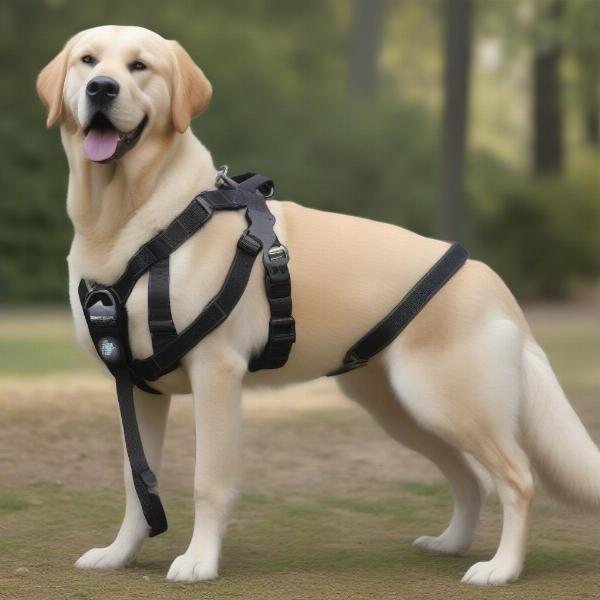A harness for a large dog is more than just a stylish accessory; it’s a crucial tool for safety, control, and comfort. Choosing the right harness can significantly improve your walks and overall relationship with your furry friend. But with so many options available, finding the perfect fit can feel overwhelming. This guide will help you navigate the world of large dog harnesses, covering everything from types and fitting to training and safety considerations.
Types of Harnesses for Large Dogs
There are several types of harnesses designed for large breeds, each with its own advantages and disadvantages. Understanding these differences is key to making the best choice for your dog’s needs.
Back-Clip Harnesses
These harnesses feature a leash attachment point on the dog’s back. They are generally easy to put on and suitable for dogs who don’t pull excessively. However, they offer less control than other types and can encourage pulling in some dogs.
Front-Clip Harnesses
Front-clip harnesses have the leash attachment point on the dog’s chest. This design provides more control and can help discourage pulling by gently redirecting the dog’s forward motion. They are a good option for strong or excitable dogs.
Dual-Clip Harnesses
These versatile harnesses offer both front and back leash attachment points, giving you flexibility in training and handling. You can use the front clip for training and the back clip for relaxed walks.
No-Pull Harnesses
Specifically designed to discourage pulling, these harnesses often feature a front clip and sometimes incorporate gentle tightening straps or pressure points. They are a good option for dogs who are persistent pullers.
 Different Types of Harnesses for Large Dogs
Different Types of Harnesses for Large Dogs
Choosing the Right Size and Fit
A properly fitted harness is essential for your dog’s comfort and safety. A harness that’s too tight can restrict movement and cause chafing, while one that’s too loose can allow your dog to slip out. Always measure your dog carefully, following the manufacturer’s instructions.
Measuring Your Large Dog for a Harness
Use a soft measuring tape to determine your dog’s girth (around the chest, behind the front legs) and neck circumference. Refer to the specific harness brand’s size chart to find the best fit. dog harness for large dogs
Adjusting the Harness for a Perfect Fit
Once you have the harness, adjust the straps to ensure a snug but not restrictive fit. You should be able to fit two fingers comfortably between the harness and your dog’s body.
Training Your Large Dog with a Harness
A harness can be a valuable tool in training, especially for leash manners.
Leash Training with a Harness
Start by introducing your dog to the harness gradually, allowing them to get used to wearing it before attaching a leash. Use positive reinforcement techniques, such as treats and praise, to encourage good leash manners. large dog harness with handle
Addressing Pulling with a Harness
If your dog pulls on the leash, a front-clip or no-pull harness can be helpful. When your dog pulls, the harness will gently redirect their attention, discouraging the pulling behavior. Be patient and consistent with your training.
Safety Considerations for Large Dog Harnesses
While harnesses offer many benefits, it’s important to use them safely.
Visibility at Night
Choose a harness with reflective strips or add reflective accessories to ensure your dog is visible during nighttime walks.
Avoiding Entanglement
Check the harness regularly for any loose straps or damage that could pose an entanglement hazard.
Conclusion
Investing in a high-quality harness for your large dog is an investment in their safety, comfort, and well-being. By understanding the different types of harnesses available and choosing the right fit, you can significantly enhance your walks and strengthen your bond with your furry companion. Remember to measure carefully, adjust the harness correctly, and use positive reinforcement training techniques for optimal results. large dog leather harness
FAQ
- What is the best type of harness for a large dog that pulls? A front-clip or no-pull harness is generally recommended for dogs who pull.
- How do I measure my large dog for a harness? Measure the girth around the chest and the neck circumference, then refer to the manufacturer’s sizing chart.
- Can I leave a harness on my dog all the time? It’s generally not recommended to leave a harness on a dog all the time, as it can cause chafing or discomfort.
- How do I clean my dog’s harness? Most harnesses can be hand-washed or machine-washed on a gentle cycle. Check the manufacturer’s instructions for specific cleaning recommendations.
- Are harnesses better than collars for large dogs? Harnesses offer more control and are generally gentler on the neck than collars, especially for dogs who pull. dog lift harnesses for large dogs
- What should I do if my dog slips out of their harness? Check the fit of the harness and ensure it’s properly adjusted. Consider a more secure harness type if needed.
- Can I use a harness for training my large dog? Yes, harnesses can be a valuable tool for training, especially for leash manners. large dog harness uk
ILM Dog is your trusted resource for all things dog-related. We offer expert advice on breed selection, health and medical care, training, nutrition, grooming, and much more. From puppy care to senior dog care, we cover every stage of your dog’s life. Let us help you provide the best possible care for your beloved companion. Contact us today via email at [email protected] or by phone at +44 20-3965-8624. ILM Dog is here to support you every step of the way.